
Some may be seduced by their graceful, delicate movements. But don’t be fooled. Industrial paint robots are relentless perfectionists, control freaks if you will, that are bound and determined to shine above the rest.
These industrial workhorses produce virtually flawless paint finishes with superhuman consistency and throughput. Like a Jedi knight, they slash operating costs and material waste. They’re fearless in the face of hazardous VOCs, combustible paint fumes and other environmental foes. Robotic painting is as much an art as it is science.
“It’s not just about volume anymore,” says Chad Henry, North American Sales Manager at Stäubli Corporation in Duncan, South Carolina. “There are also quality and consistency aspects. You may have a low-volume, high-dollar part. Cosmetically, this component must be perfect. You simply cannot get repetitive performance with manual operation.”
Gone are the days when robotic painting was reserved for only large OEMs with deep pockets. Like all robotics technology, paint robots have become more viable for top-tier supplier bases in the automotive and transportation industries. They’re also gaining ground in smaller, general industrial applications, where apprentices are poised to explore the tried-and-true methods of early adopters.
 "There’s very little argument anymore about the merit of automation compared to manual paint application among the automotive industry,” says Ed Minch, Director of Sales & Engineering-Automotive/General Industries at Kawasaki Robotics (USA) Inc. in Wixom, Michigan. “The justification for purchase changes with the economy, the price of gas, consumer confidence … Everybody is screaming for more capacity at the moment.”
"There’s very little argument anymore about the merit of automation compared to manual paint application among the automotive industry,” says Ed Minch, Director of Sales & Engineering-Automotive/General Industries at Kawasaki Robotics (USA) Inc. in Wixom, Michigan. “The justification for purchase changes with the economy, the price of gas, consumer confidence … Everybody is screaming for more capacity at the moment.”
He says the mindset is starting to trickle down to other industries. “Paint is a very complex process. It’s dangerous work; it’s hard work. It’s easier to teach somebody how to program a robot than it is to teach them how to paint.”
“Trending technology is always driving toward reducing waste, energy consumption, cycle time, footprint and capital equipment,” says Minch. “Robots need to be lighter, less obtrusive and more efficient, with greater reach capability, while processing more detailed and intricate parts. Streamlined robot and applicator designs and the ability to do more work in less space are becoming very important. All of these things lead to cleaner, higher quality processes, with minimal manual involvement.”
Top-Tier Paint Lines
Headquartered in Warren, Michigan, SRG Global Inc. and its subsidiaries are a Tier 1 supplier of painted and chrome-plated plastic components for the automotive, commercial truck and household appliance industries. Worldwide, SRG Global employs more than 50 painting robots. The company has high-volume robotic paint lines at three of its manufacturing facilities in Newbern, Tennessee; Morehead, Kentucky; and Boleslawiec, Poland.
“We specialize in painting automotive exterior components: body side moldings, grilles, lamp bezels, window surrounds, anything that has a painted finish and attaches to the body of the car,” says Aaron Watters, Paint Area Manager at SRG Global in Newbern, Tennessee.
SRG Global’s paint lines use pedestal-mounted, 6-axis articulating robots for primer, basecoat and clearcoat applications. The components to be sprayed are mounted on fixtures, or paint racks, which continuously pass by the robots on conveyors. Underneath the covers are Fanuc paint robots.
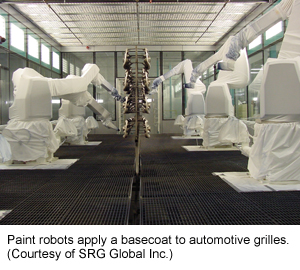 “The robots that we use at our Morehead and Newbern facilities are the same robots that they use to paint car bodies in automotive factories,” says Watters. The robots are integrated with a conveyor tracking system to keep tabs on where the parts are at any given moment. The parts are always moving for maximum volume through the system.
“The robots that we use at our Morehead and Newbern facilities are the same robots that they use to paint car bodies in automotive factories,” says Watters. The robots are integrated with a conveyor tracking system to keep tabs on where the parts are at any given moment. The parts are always moving for maximum volume through the system.
The robots are located on both sides of the conveyor. Watters says this helps with paint utilization. “The overspray actually lands on the back and side edges of the part on the opposing side of our paint fixtures, so you get maximum paint coverage that way.”
SRG Global also has robotic paint systems at three other manufacturing facilities, which employ smaller, pedestal-mounted robots and smaller paint booths for second-finish applications.
A Broad Palette
With a shrinking supplier chain to the automotive OEMs, there is mounting pressure on suppliers to accommodate more vehicle brands and models. Plus shorter runs and quick changeovers have become the norm rather than the exceptions.
Transformed in 2001 from an old Penguin Putnam book distribution center, SRG Global’s 433,000-square-foot Newbern facility is considered state of the art in plastics molding and painting. The Tier 1 supplier’s paint robot integrator explains.
“This plant in Newbern is probably one of the nicest paint shops in the U.S. The main difference is that these guys knew when they built the plant that they wanted to handle various product lines,” says Michael McLaughlin, President of Generic Systems Inc. in Sylvania, Ohio. “The implication is that you’re going to run a lot of part styles, but you’re also going to run a lot of colors.”
Ordinarily, a paint robot might be operating a standard color changer that has 16 colors,” explains McLaughlin. “That would be typical in automotive; they make 16 colors of car bodies. But for the suppliers, they can get more work if they paint more colors. That particular plant is capable of running in excess of 300 production colors.”
McLaughlin says all of the lines feeding into SRG Global’s basecoat color robots are piggable. A piggable system uses a bullet-shaped foam device called a ‘pig’ which, at the end of a color run, is shot through the paint system with compressed air and a minimal amount of solvent to force paint out of the lines. This minimizes color-change time and paint/solvent waste.
“These guys can take any work because they have an unlimited color palette,” says McLaughlin. “I’ve got to hand it to them. They had the foresight to do it that way.”
The challenge to the integrator is to create a system that keeps track of all those colors. Generic Systems specializes in control system design and integration of coating and fluid delivery systems.
“We created a system for SRG Global with a three-digit job number and a system color, which is tracked and used throughout the entire plant,” says McLaughlin. “The molding people use that system job number to determine what die goes into the machine. Then, when the painting people in the mix room see that system color on their screen, they know what color to load and when. It’s all completely integrated from the mold area all the way to the paint booth.”
Fluid Flow Control
The majority of SRG Global’s painting robots have closed loop paint process control. According to Watters, it’s important that paint systems are equipped with this level of control support for the robots. He notes that it eliminates problems with under or over film build, and reduces waste.
Fluid flow control is achieved by two, different methods. Closed loop is software-based and uses a gear meter to monitor the flow rate. Positive displacement uses a mechanical gear pump to control flow.
Kawasaki’s Minch, a recognized authority on automated paint shop processes, says this level of control is the standard among automotive OEMs. “The tighter you can control your process, the more accurate you can be. The higher your quality, the lower your costs, that’s why we use closed loop or positive displacement flow control. We want to make sure that the volume of paint coming out the applicator is consistent regardless of what happens to the chemical properties of the paint.”
He explains the role viscosity plays. “Viscosity can be affected by temperature (viscosity is inversely proportional to temperature), by shear because it’s always circulating in these pipes, and by the amount of solvent added to keep the paint at the specified spray viscosity. Closed loop gives you the ability to vary the amount of air pressure you have on the paint regulator to increase or decrease the amount of flow. With positive displacement we use gear pumps, and a specific number of CCs (cubic centimeters) are dispensed from the applicator for every revolution of the gear. Gear pumps or closed loop flow are the primary ways we’re dispensing material accurately.”
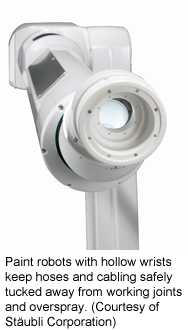 Hollow Wrists
Hollow Wrists
Another fairly standard feature on paint robots is the hollow wrist design. All of the robots on SRG Global’s high-volume paint lines have hollow, three-roll wrists equipped with electrostatic paint guns and/or rotary atomizers, often called bell applicators.
The hollow wrist allows for hoses and cabling to be housed in the cavity of the robot arm. This function increases the robot’s reach and access to the workpiece, minimizes wear on the connections and cabling, and reduces contamination risks.
This video courtesy of Kawasaki Robotics shows hollow, three-roll wristed robots at work applying primer, basecoat and clearcoat to plastic motorcycle cowls. These nimble painters perform without concern for carpal tunnel syndrome.
The Stäubli TX250 is a 6-axis paint robot with a hollow wrist that can be integrated with a spray gun. “At the elbow we can put in solenoid valves along with input/outputs to manage the gun control,” says Henry. “Now you don’t have any cables flopping around on the outside of the robot, getting caught or breaking. The robot has a specific reach which covers the majority of applications we see for painting.”
Henry notes that reach and flexibility are key considerations for paint robots. The robot must be able to reach across a relatively large part to paint it and then tuck itself into a smaller area to avoid interference with other operations. The TX250 can be inverted and ceiling-mounted for that purpose.
The robot is also coated with a smooth, epoxy finish that’s resistant to the chemicals used in painting processes. “You can, but you don’t have to cover our arm,” he adds.
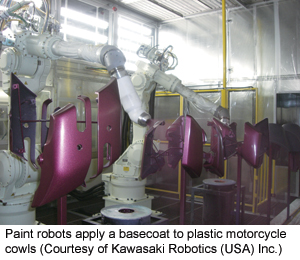 The Kawasaki KJ314 painting robot also has a hollow wrist and a lightweight, cast aluminum construction for greater flexibility. “We integrate process equipment into the robot arm, so that you don’t have a separate channel to house proportional transducers or our solenoid valves,” says Minch. “We put them right into the explosion-proof cavity in the robot.”
The Kawasaki KJ314 painting robot also has a hollow wrist and a lightweight, cast aluminum construction for greater flexibility. “We integrate process equipment into the robot arm, so that you don’t have a separate channel to house proportional transducers or our solenoid valves,” says Minch. “We put them right into the explosion-proof cavity in the robot.”
“That gets them very close to the application point. So we also have a servo drive on the robot arm that you can use to control a gear pump for positive displacement, and that’s directly from the robot controller itself with its own motion group. This winds up providing a very clean process solution.”
Arms Overhead
The KJ314 is a 7-axis pedestal robot, which Minch says is very unusual, meaning it has two waists. “The robot can be mounted overhead, and because it has two waists, it can rotate in two directions, horizontally and vertically, and actually reach down and paint an entire plastic part (such as an automotive bumper) with a single robot.”
Minch says there’s a trend toward elevated-mount robots. “It took a while to convince customers that having robots overhead was a good idea. But they soon figured out that if the robot is mounted up high, the whole robot itself stays very clean and the overspray goes down into the grating. So that has become the trend, to keep the equipment elevated and out of the actual process area and it lasts a lot longer.”
Overhead-mounted robots and high-density layouts can also substantially reduce the width and length of paint booths, conserving valuable floor space. Lower energy consumption is another benefit.
Make it lighter, faster and more compact. Make it cleaner and more streamlined. The challenges for paint robot manufacturers are the same. As such, many of the robot OEMs will admit that what really 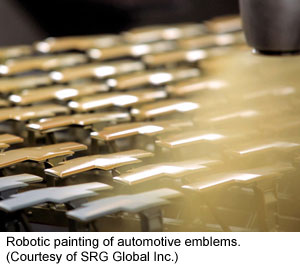 differentiates the process is the integration.
differentiates the process is the integration.
“It’s the process that drives the project,” says Minch. “Integration of the painting and process equipment, the user interface with process control, the realization of expected ROI, and after-sale support are more likely to influence whether a customer perceives a purchase to be a success. It’s the whole package.”
Make It User Friendly
The whole package is what makes SRG Global’s process successful. It’s a fully integrated system that ties all the different stages of production together with a user friendly graphical interface, a sophisticated process tracking system, memory backup and remote access.
“One of the most important functions of the robot integrator is the software integration that makes that interaction between the robot and the operators a user friendly experience,” says Watters. “That’s critical when you’re dealing with manufacturing, when you need that bridge between technology and your floor associates to be able to work with each other. The integrator also adds a lot of control options, what we typically call poka-yokes (mistake-proofing).”
One of the poka-yoke processes that Generic Systems installed for SRG Global is a user friendly, integrated graphical interface. McLaughlin said that when the system was first installed it was unusual for a supplier to have that level of sophistication.
“Everything is graphically represented, whether it’s the mix room, the molds or the inspection station. All these different operations are integrated. It’s configurable (resin for mold process, catalyst, system colors, clearcoat) and easy to use.”
Watters says that it still takes a high level of skill to create new programs. SRG Global has paint process engineers who do the programming. Generic’s integration software takes care of the day-to-day operations.
“Our paint technicians can actually check all the process parameters just by looking at the screen,” says Watters.” They can verify that the right amount of paint is coming out of the gun, that the right part came into the booth, and that the robot is running the right program. So it’s very user friendly.”
Traceability
“The integrator is also very important for integrating all those process parameters with tracking systems,” says Watters. “We have tracking systems that actually record all of our variables in databases. So say a part comes back from a customer two years from now, we have traceability with special labels on the part. We can trace that down to a date and actually go into the databases and track down all the process parameters that we used on those days.”
He says the robot integrator also provides external memory banks to hold all that data. “This is very important, especially for suppliers like us, because we offer our customers hundreds of different colors and different part styles.”
“We provide our customers with top quality and lower the risk of getting bad parts, because we have all those tie-ins integrated with the robots,” he adds. “We let the robots be smart about their processes. They track what they do, and then we record what they do, so we can tell right on the spot when they’re not performing properly.”
Planes, Trains and …
Beyond automotive top-tier applications, robotic painting is making inroads into diverse industries. From bicycles and furniture, to cookware and medical devices, from the smallest to the largest applications, paint robots are leaving their mark.
 Henry says Stäubli’s painting and coating applications run the gamut. Robots are being used to paint bicycle frames, wood furniture and consumer electronics. They apply nonstick coatings on pots and pans, and even spray enamel on bathroom sinks.
Henry says Stäubli’s painting and coating applications run the gamut. Robots are being used to paint bicycle frames, wood furniture and consumer electronics. They apply nonstick coatings on pots and pans, and even spray enamel on bathroom sinks.
“Painting robots offer flexibility,” says Henry, “because the robot can adjust to part variability and part volume changes relatively quickly and at a low cost. You can easily teach or reprogram the robot to do new tasks.”
He describes another robotic application in the medical industry where silicon coatings are applied to the plungers of syringes to reduce friction and wear. “You really can’t do that with manual application. The silicon goes on clear, so it’s almost impossible to see with the naked eye. The robot maintains a very consistent pattern and then a vision system is used to inspect the quality of the process.”
On a much larger scale, commercial jet airliners are spreading their wings and embracing robotic painting. OEMs looking to raise quality and lower costs are using robots to paint entire wing assemblies.
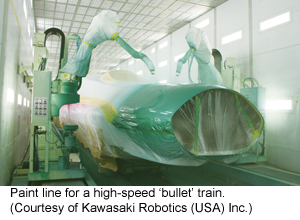 Back on land, the Shinkansen high-speed railway line uses robots to achieve lightning-fast paint application on the bodies of its ‘bullet’ trains. These track blazers encounter harsh environments as they crisscross Japan at up 320 km/h (200 mph).
Back on land, the Shinkansen high-speed railway line uses robots to achieve lightning-fast paint application on the bodies of its ‘bullet’ trains. These track blazers encounter harsh environments as they crisscross Japan at up 320 km/h (200 mph).
Painting Outside the Lines
As technology continues to advance and ownership costs recede, robotic painting and coating is expected to appear on the scenes of myriad industries. Perhaps out of the paint booths and into new frontiers that we can’t yet imagine (think additive manufacturing).
Wherever their gentle mists take them, paint robots will never relinquish their pursuit for the perfect finish.

